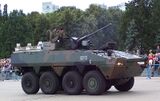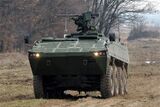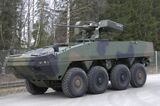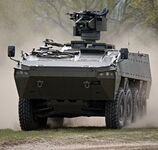MOT-27 Gazelle: Difference between revisions
No edit summary |
m (1 revision imported) |
(No difference)
| |
Revision as of 23:02, 25 February 2019
This article is incomplete because it is pending further input from participants, or it is a work-in-progress by one author. Please comment on this article's talk page to share your input, comments and questions. Note: To contribute to this article, you may need to seek help from the author(s) of this page. |
| MOT-27 Gazelle МОТ-27 Газела | |
|---|---|
 MOT-27 of the Nikolian Imperial Ground Forces | |
| Type | Armored Personnel Carrier |
| Place of origin | |
| Service history | |
| In service | 2003 - present |
| Used by | |
| Production history | |
| Designer | VTI |
| Designed | 1995 |
| Manufacturer | VTI |
| Unit cost | 2.1 million NSD 1.4 million NDK |
| Produced | 2000 - present |
| Specifications | |
| Weight | 13 to 27 tonnes |
| Length | 7.7 m |
| Width | 2.8 m |
| Height | 2.3 m |
| Crew | 2-3 (commander, driver, optional gunner) |
| Passengers | 8-12 passengers |
Main armament | 15.7 mm RAKD machine gun or 27 mm MANAR autocannon |
Secondary armament | 8.54 mm RAMD machine gun |
| Engine | FMK-743 diesel 550hp or 480hp |
| Suspension | Wheeled 8 x 8 independent hydropneumatic suspension |
Operational range | 600-850 km |
| Speed | over 100 km/h on land up to 10 km/h in water |
The MOT-27 Gazelle (Serbian: Модуларни Оклопни Транспортер Газела, Modular Armored Transporter Gazelle) is an 8x8 multi purpose military vehicle produced by the Nikolian VTI (Vojno-Tehnički institut / Military technical institute)
Its main feature is modular chasis, which allows the incorporation of different turrets, weapons, sensors, or communications systems on the same carriage. Designs exist for different APC vehicles (armoured personnel carrier) and IFV versions (infantry fighting vehicle), communications versions, ambulances and different fire support versions, armed with large caliber mortar and gun systems. Due to the mine-resistant feature, it can withstand explosions of up to 10kg of TNT. The frontal arc can withstand a 30mm APFSDS round. Another important feature of MOT-27 is good mobility on rough terrains, and capability of achieving great speeds on land.
History
In 1998, the Nikolian Military Technical Institute (VTI) started developing a new, cheap and reliable armored personnel carrier in order to replace the aging BOV-5 vehicles. VTI engineers used the experience from combat and saw that the vehicle should have good mobility, good protection and good armament. Soon after, an idea to have a modular armament was brought by VTI's chief engineer, and the first prototype was tested in 2000. The first prototype was armed with a remote-controlled 12.7mm heavy machine gun placed on a newly designed modular turret. Seeing the benefit of this programme, the Ministry of Defence increased funding in order to speed up the development. To the end of 2001, the team of engineers constructed 3 modular turrets carrying 20mm cannon, 27 mm MANAR cannon and 30mm cannon respectively.
Versions
- MOT-27A a turret-less version that can carry 12 soldiers
- MOT-27B1 a version with a single 7.62mm PM-1 machine gun and 53mm RMB-53 grenade launcher mounted on Viktor RWS platform
- MOT-27B2 a version with 12.7mm PATM heavy machine gun
- MOT-27M1 a version with 27 mm MANAR cannon mounted on a manned turret
- MOT-27M2 a version with 30mm RT-30 cannon with two anti-tank missiles mounted on a Viktor 2 RWS platform
- MOT-27/PT-105 a version with 105mm PTT-12 cannon
- MOT-27H ambulance version (unarmed). Can fit 10 wounded soldiers
Users
Arabona uses special version with CC-58 turret designated MOT-27AR
Aswick uses 400 MOT-27M1's, 75 MOT-27H's and 25 MOT-27A vehicles.
New Pangus uses 450 MOT-27M1's, PT-105's, MOT-27B2's, MOT-27M2's, MOT-27B1's, MOT-27H's, and MOT-27A's.





